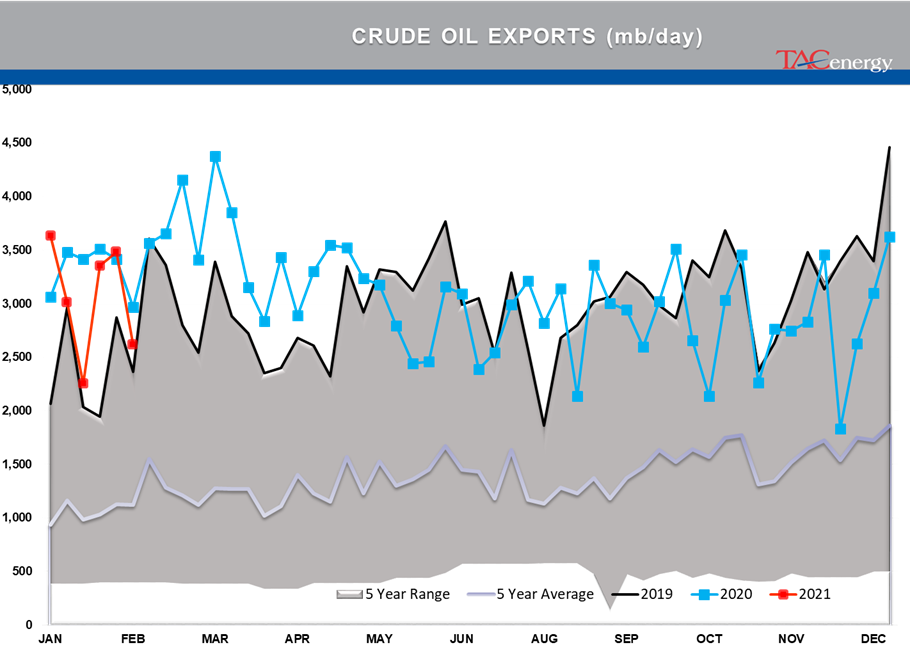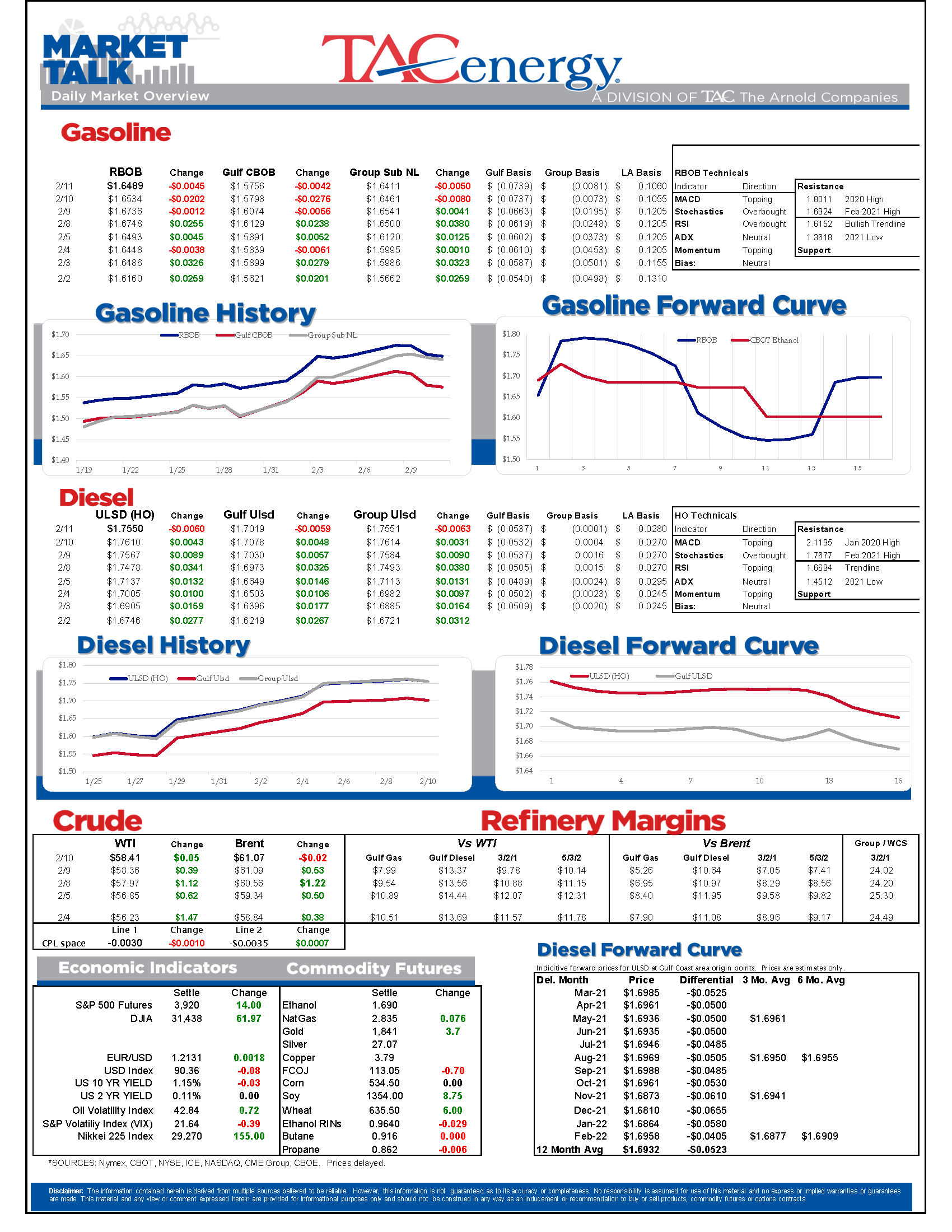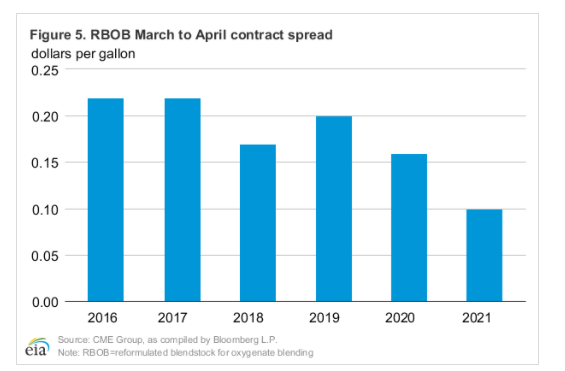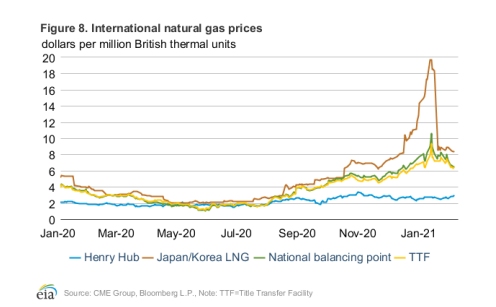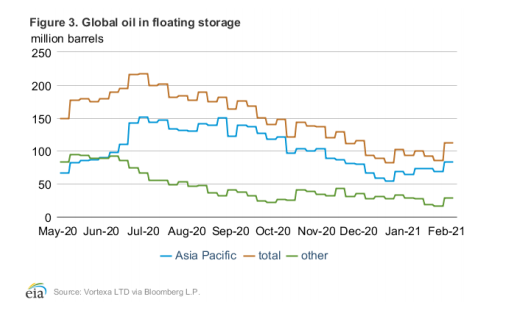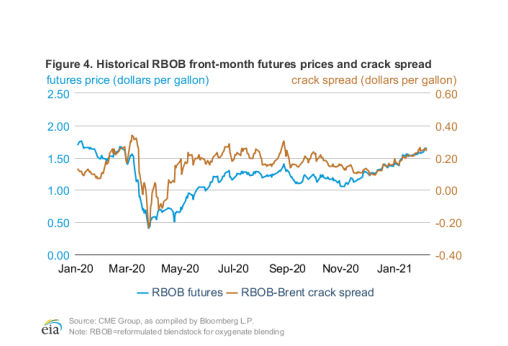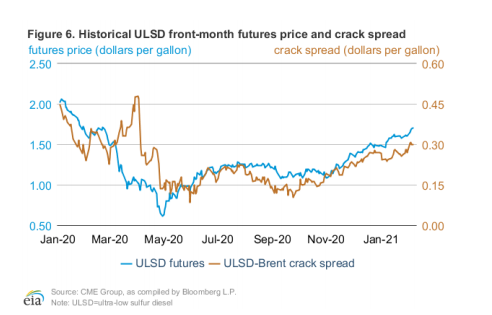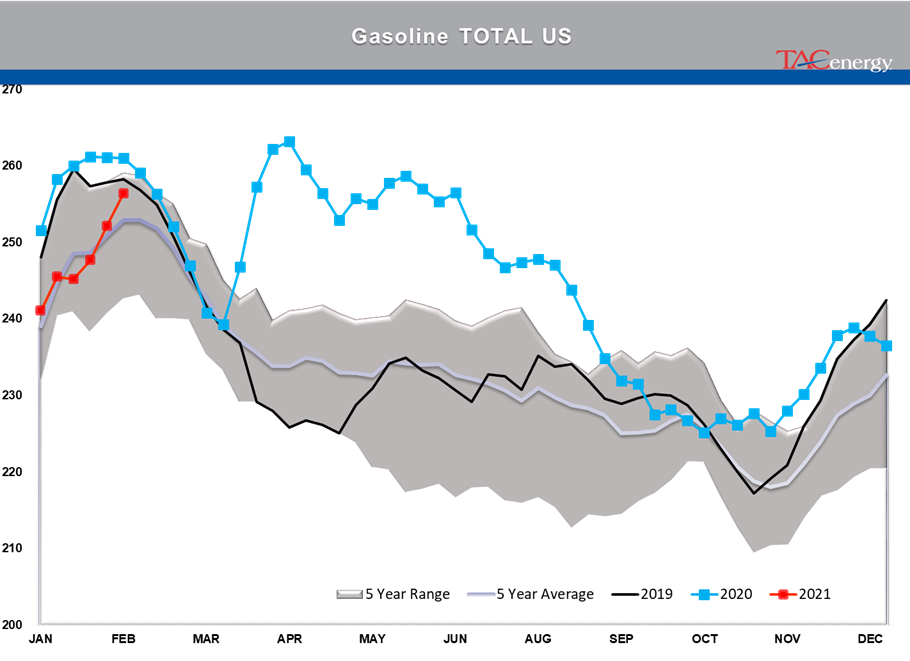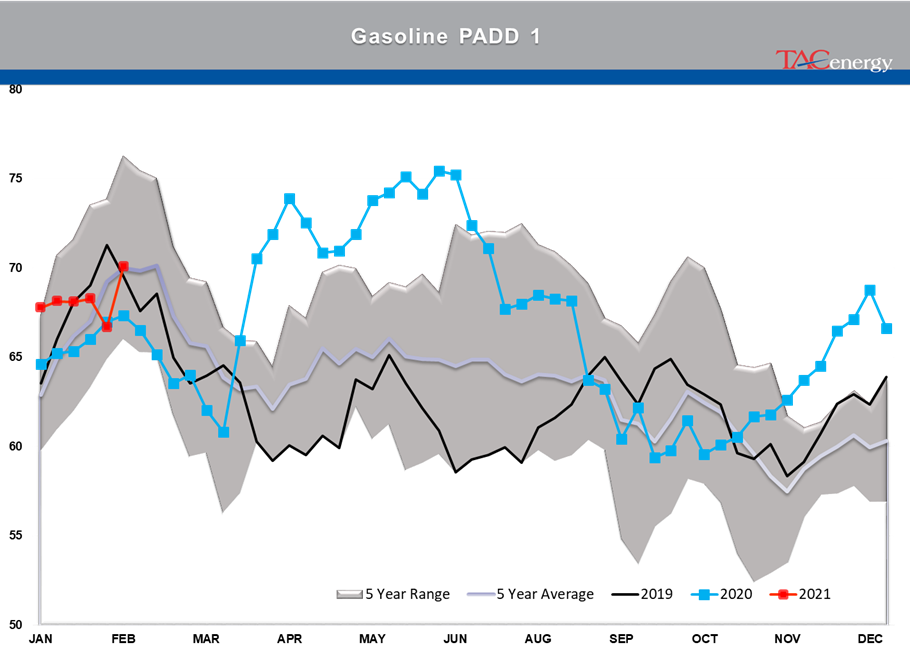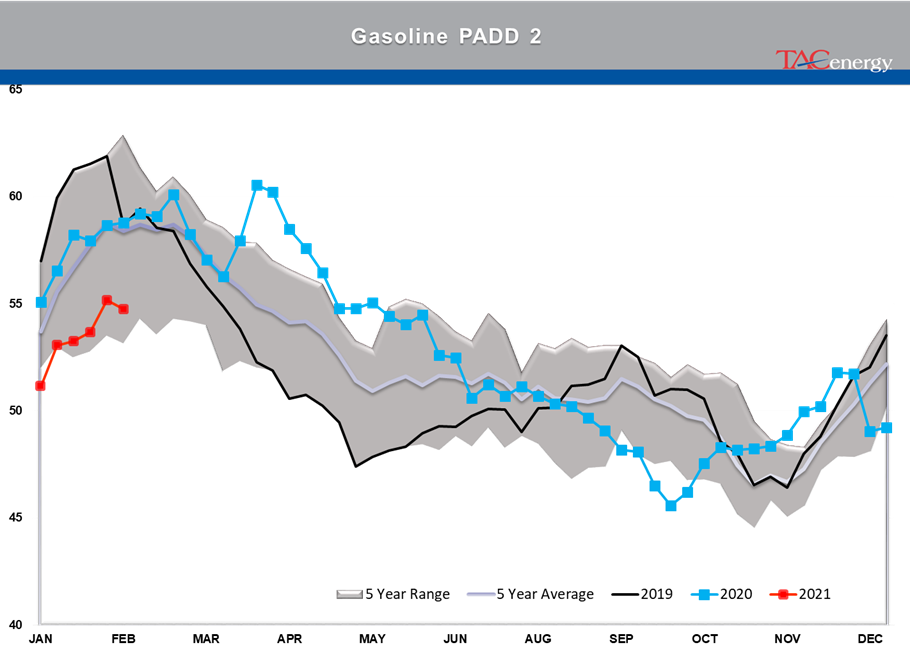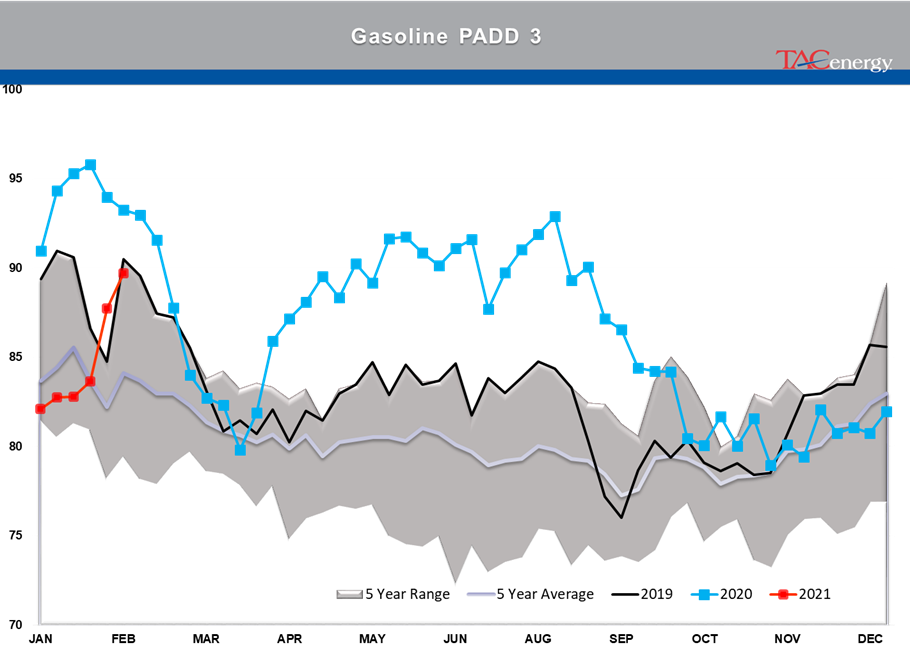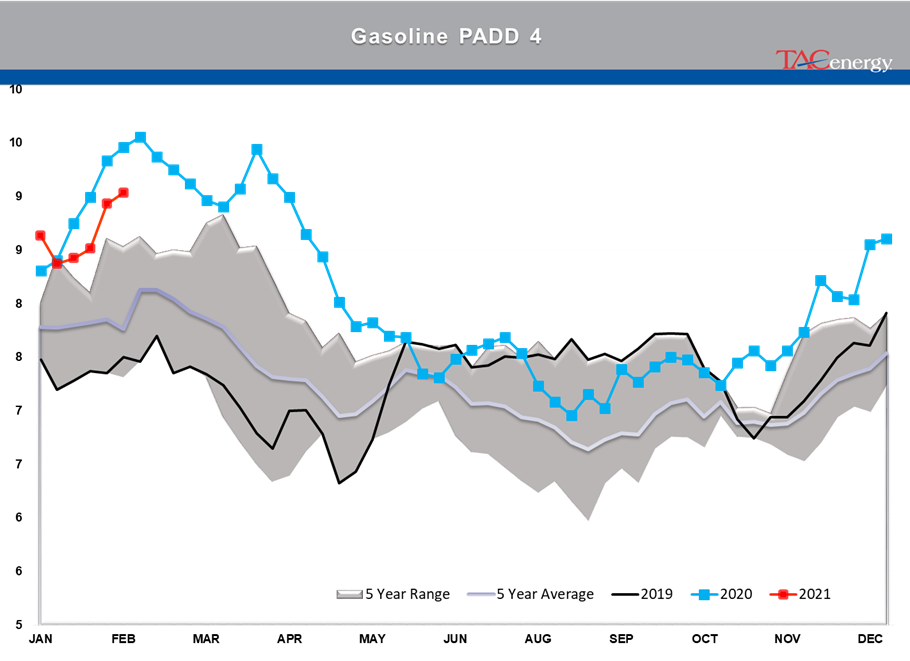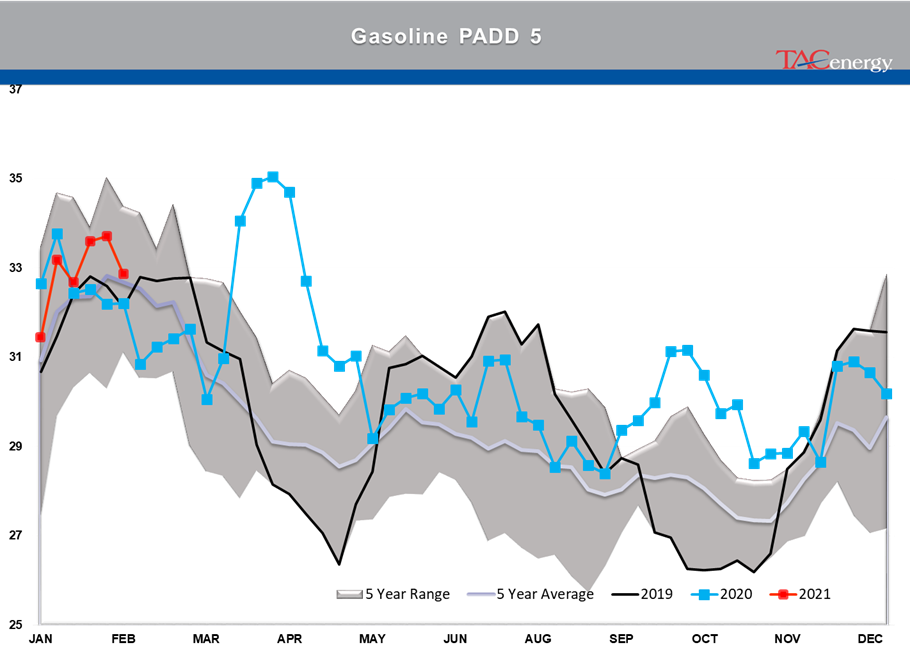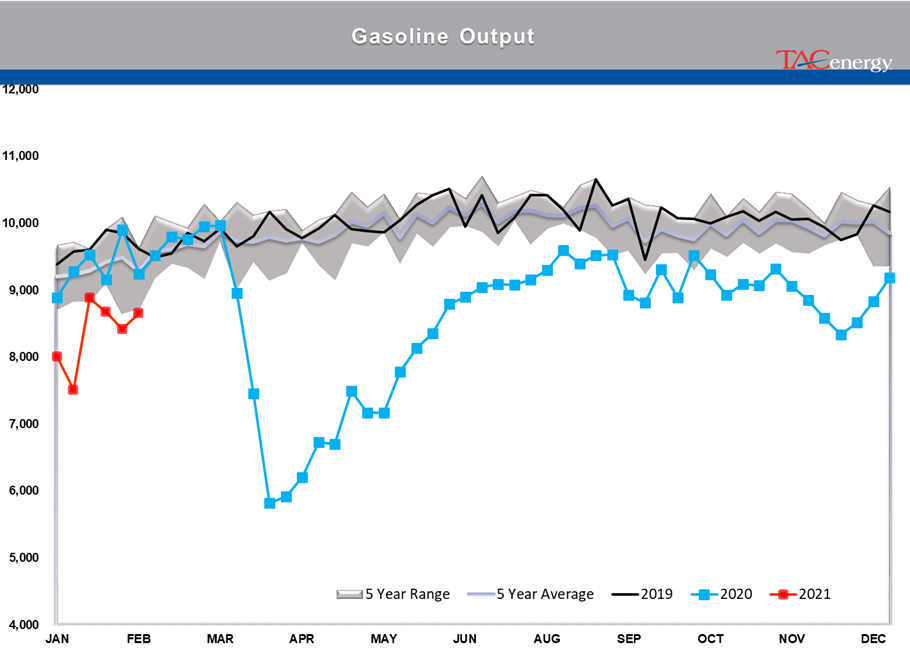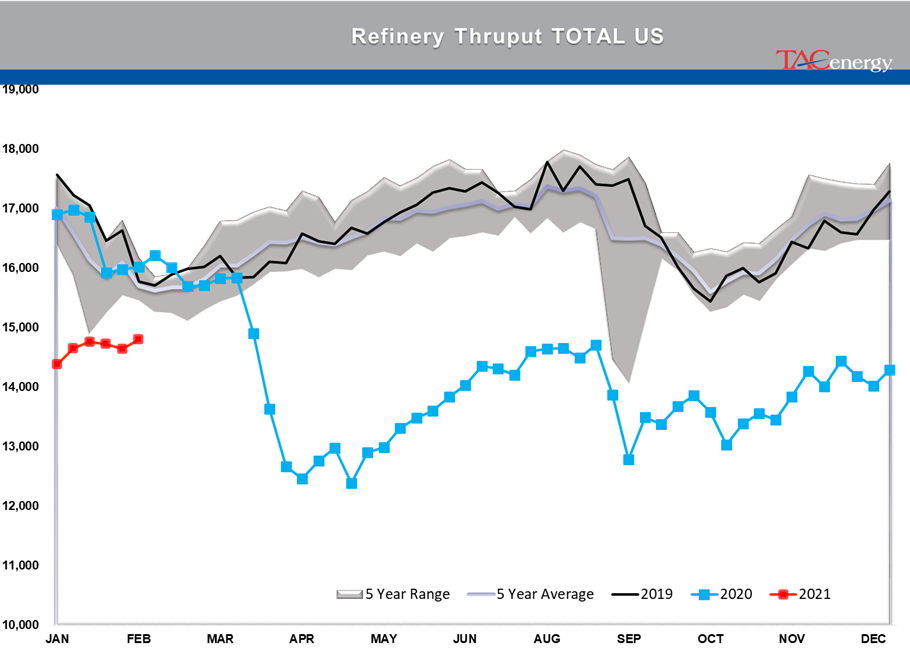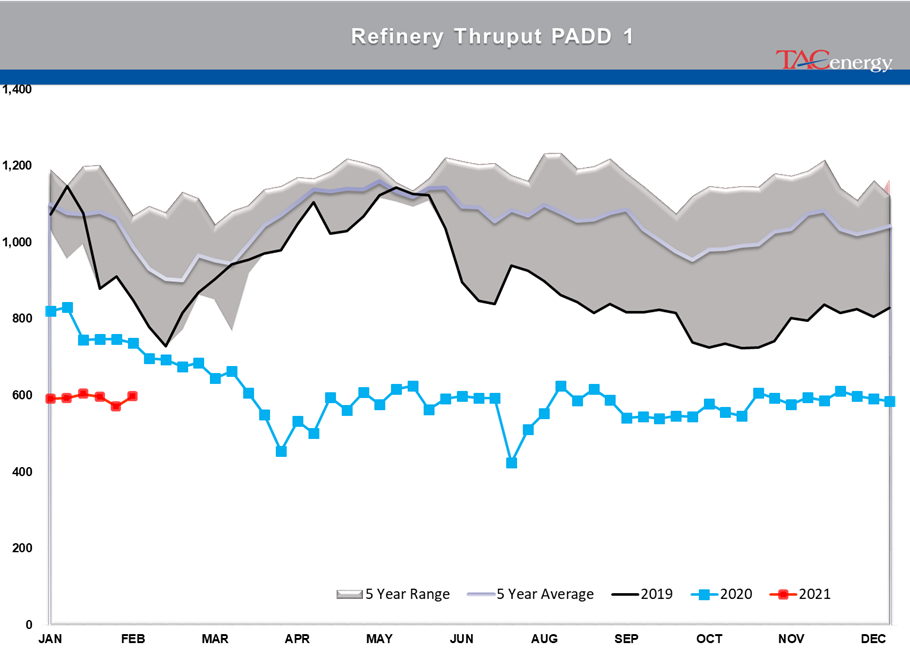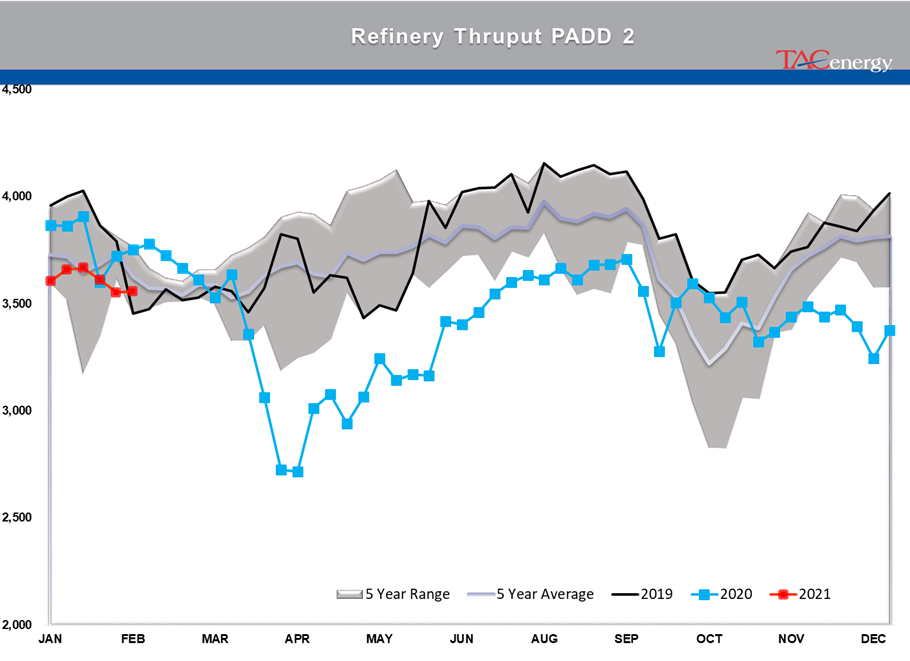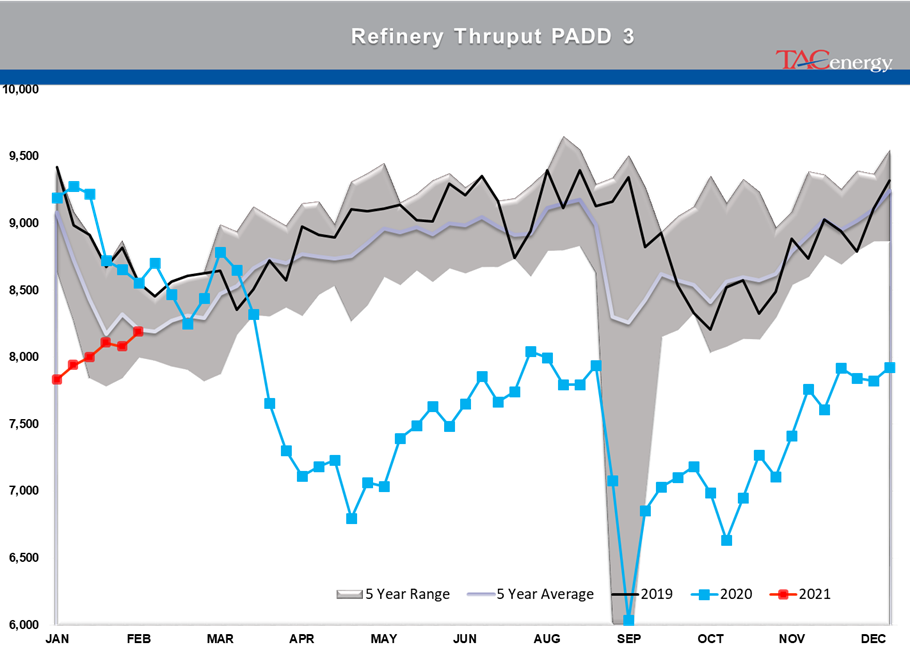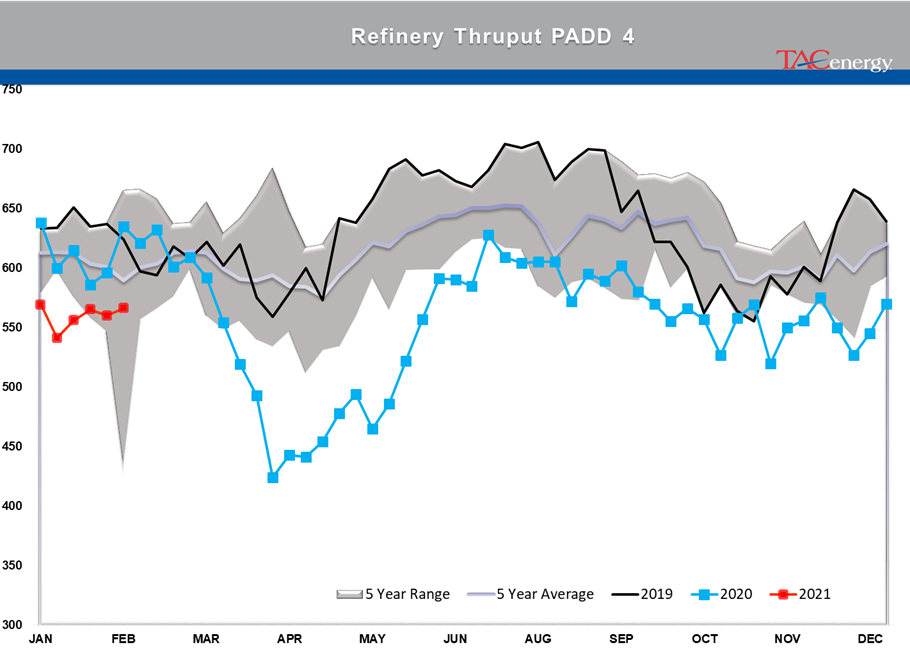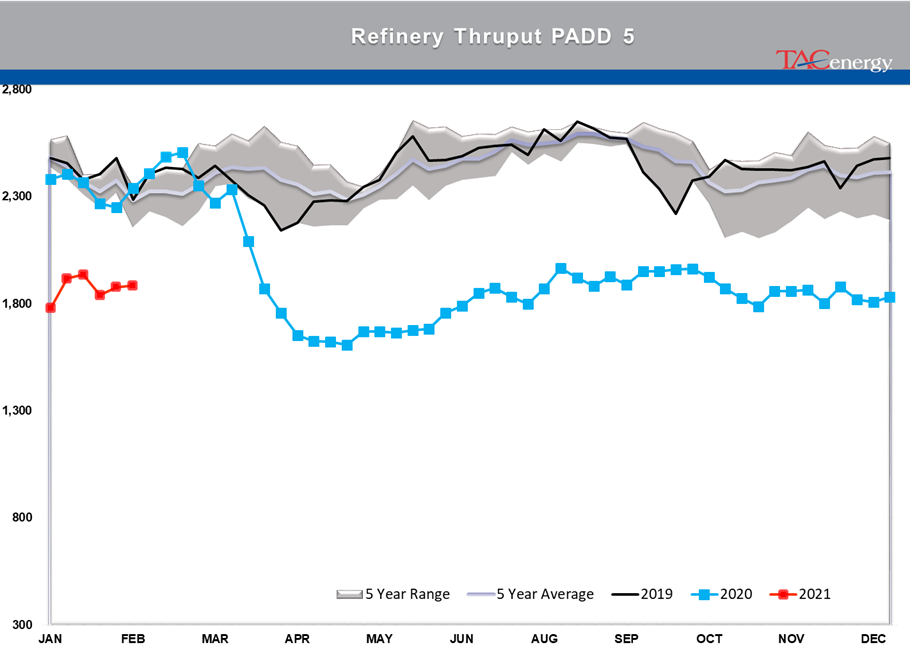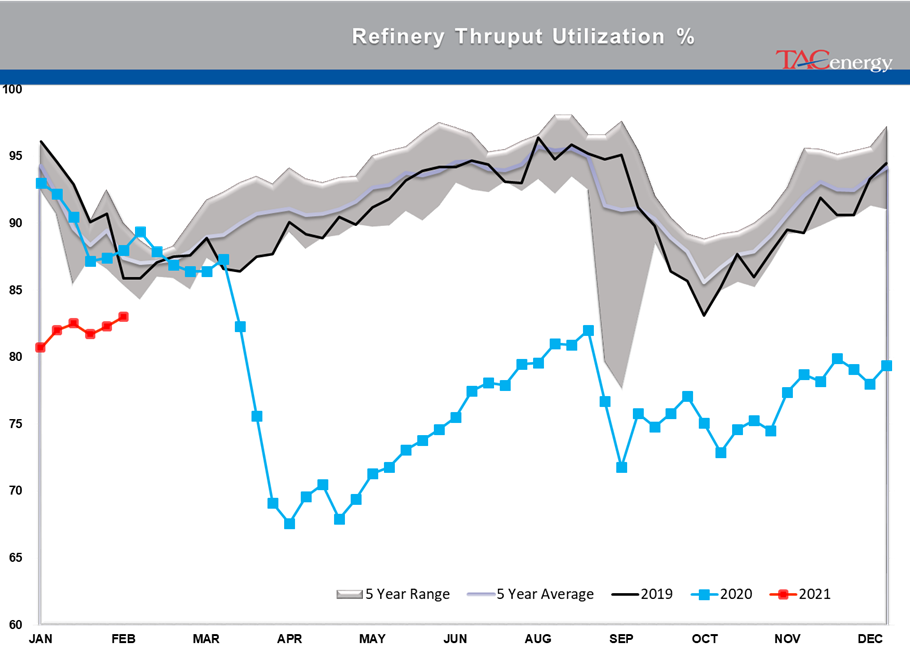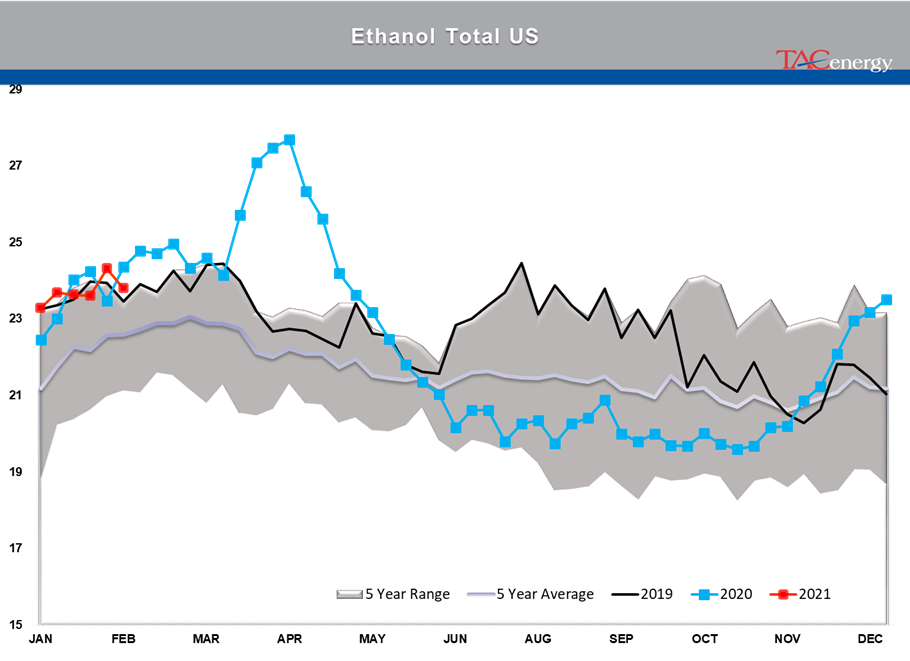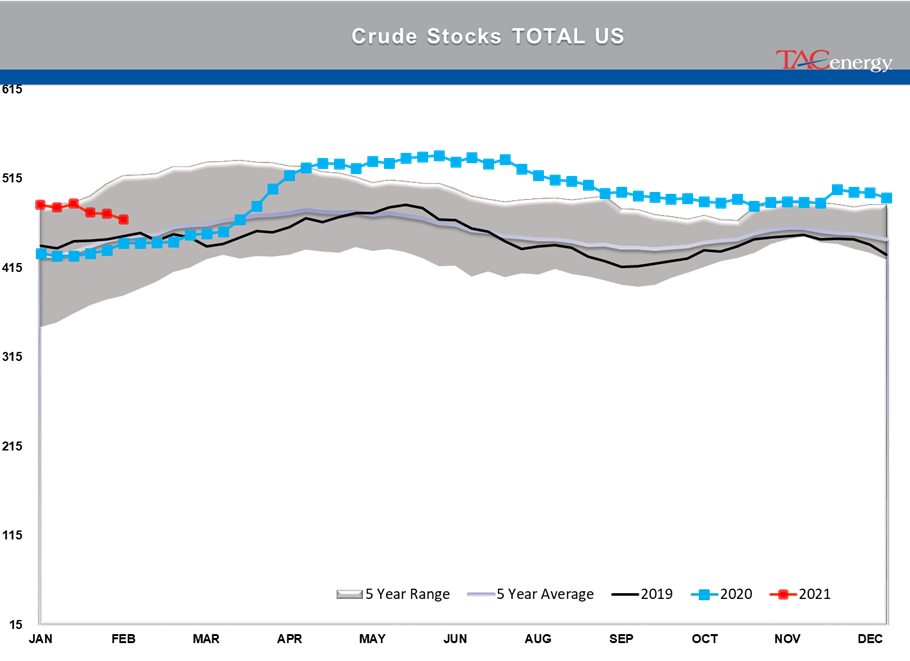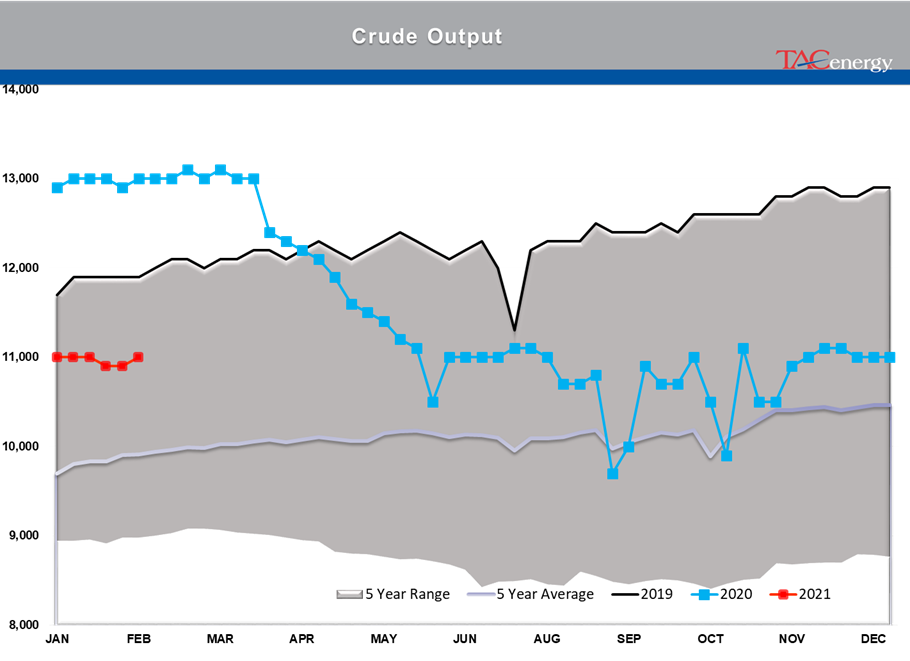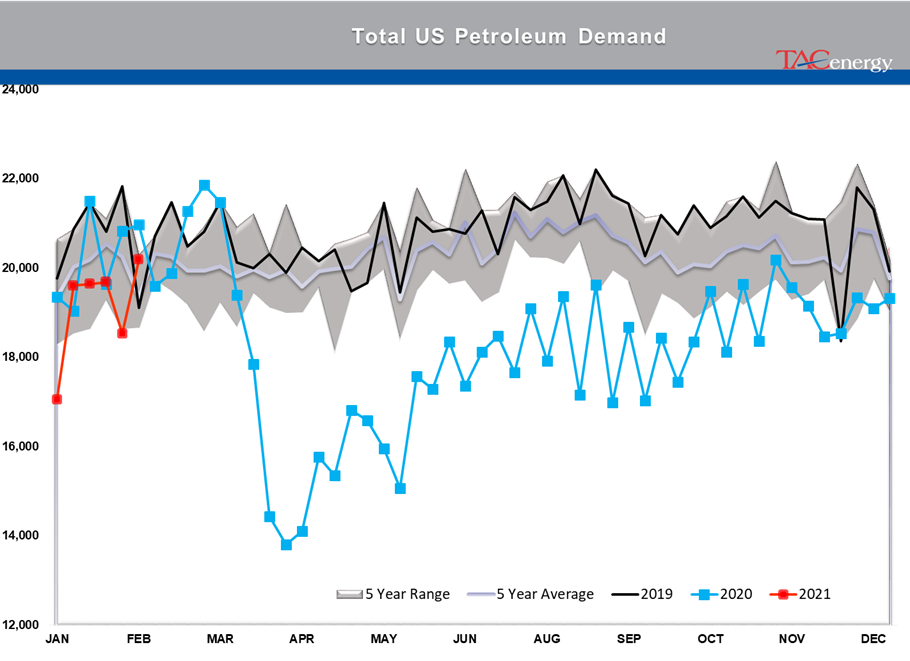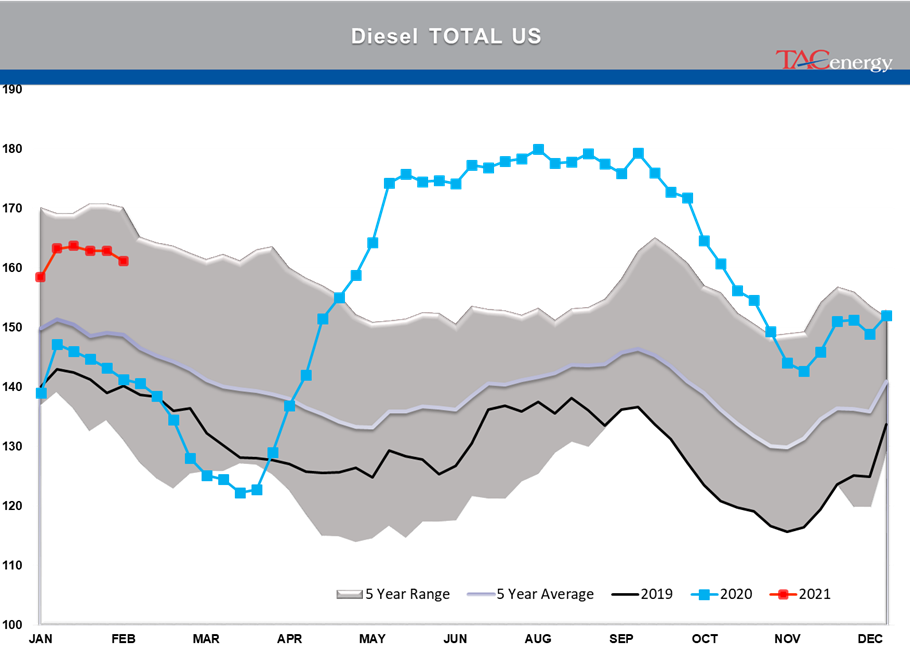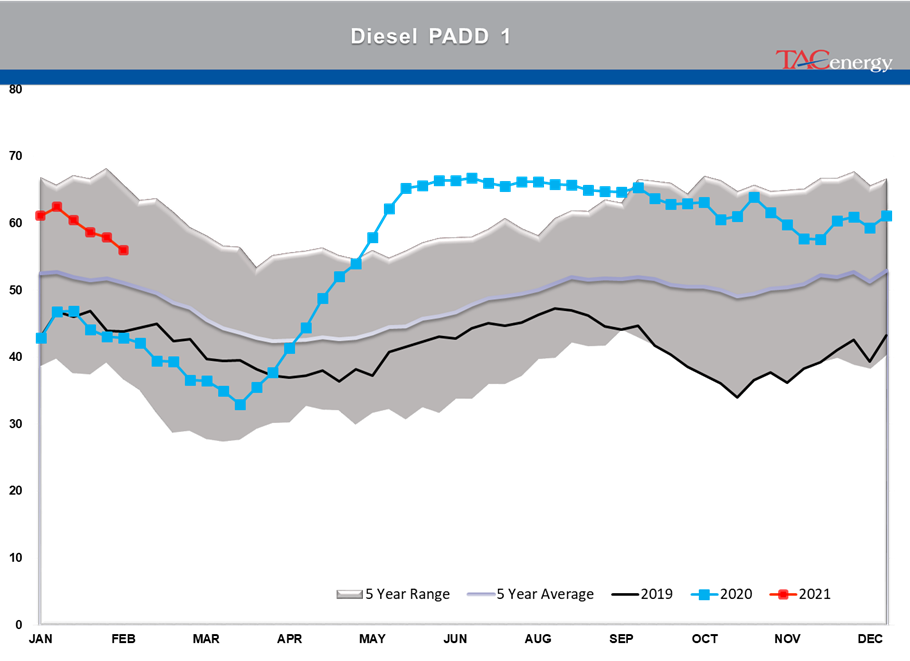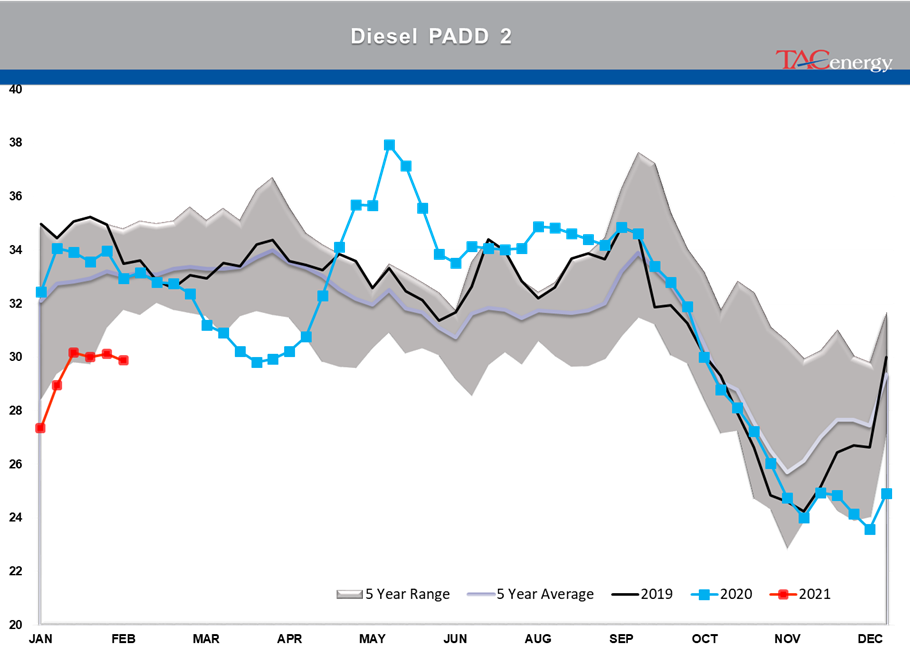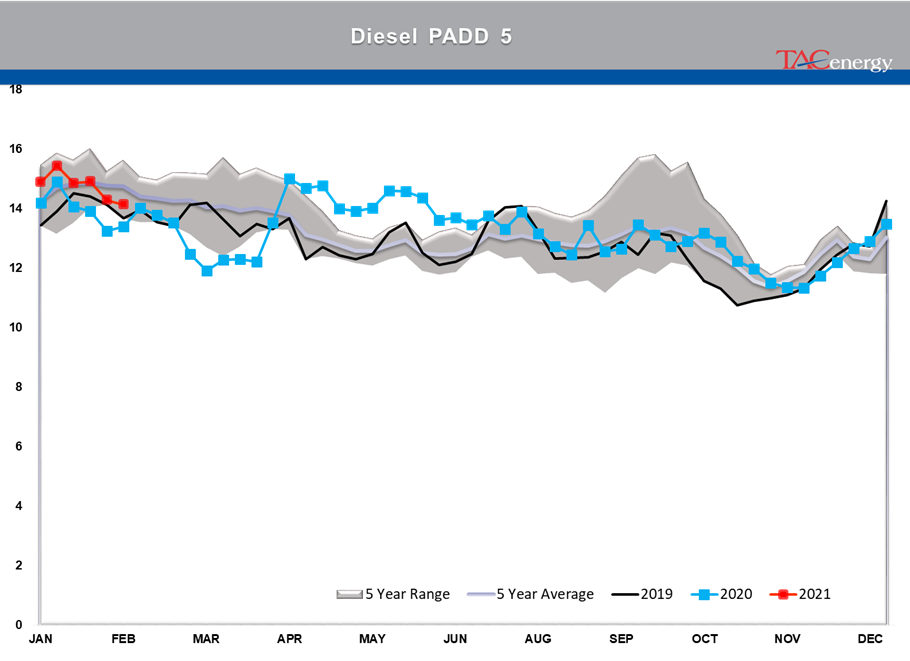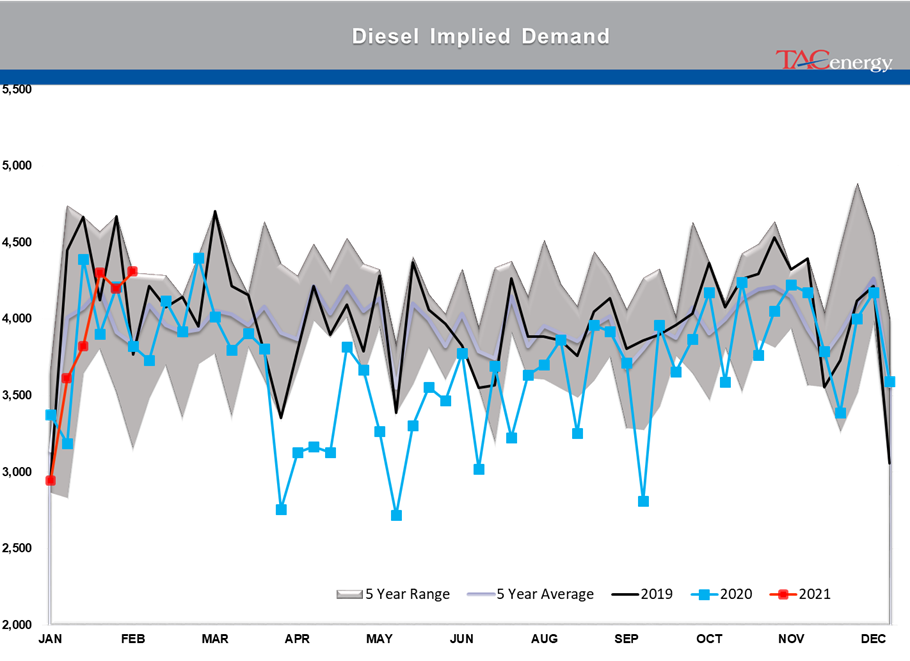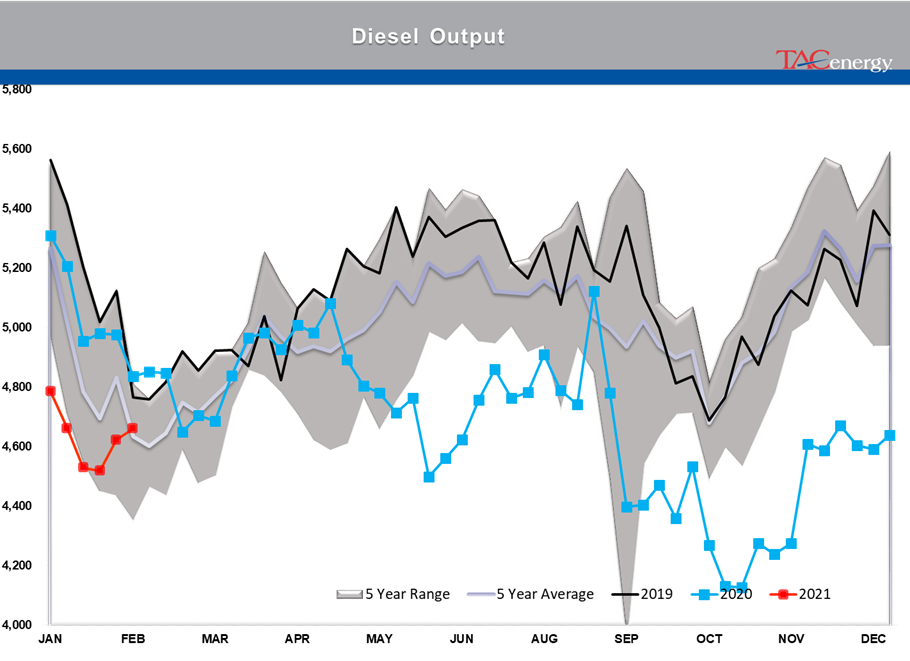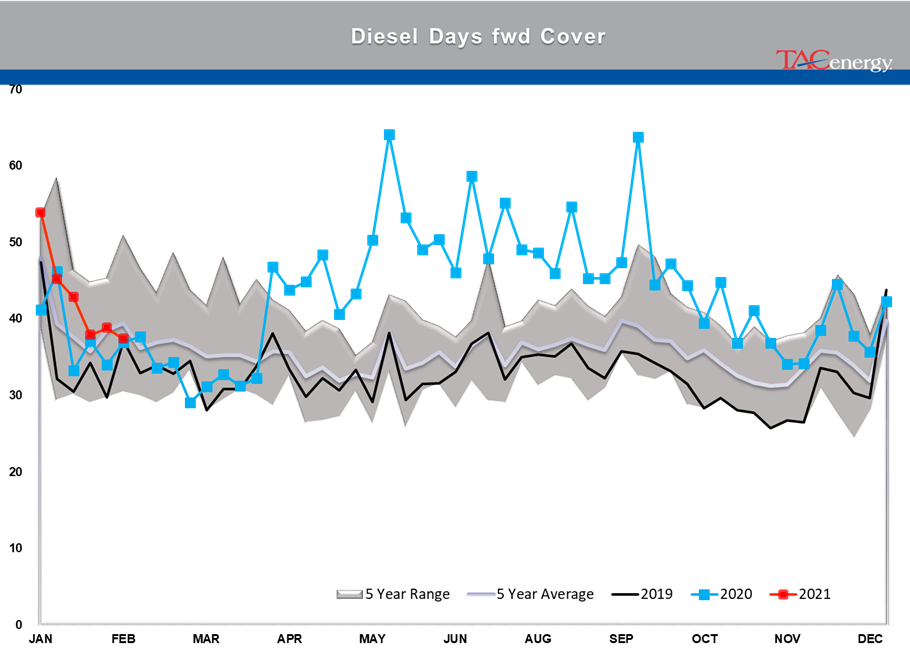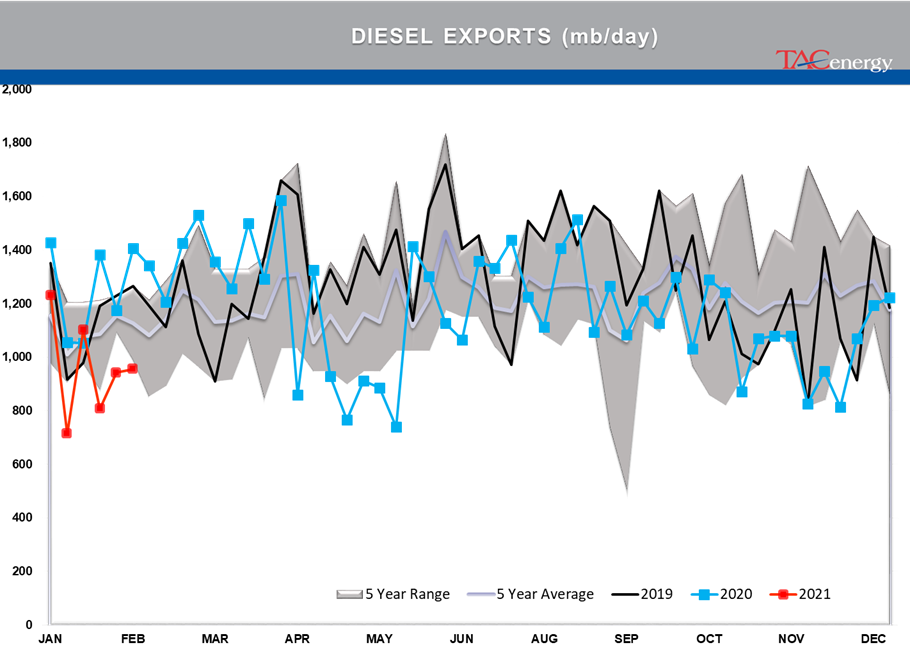Moving Through February Demand Doldrums

Energy prices are seeing a modest pullback to start Thursday after WTI and ULSD futures stretched their winning streak to eight straight sessions on Wednesday, reaching new one-year highs in the process. Some sobering fundamental data seems to be giving the market reason to pause, although the trend-lines are still intact and pointing higher for now, and prices have already bounced off of their overnight lows.
Gasoline prices are faring the worst this week as we move through the February demand doldrums with a parade of winter storms and record-setting cold on tap for the next week.
The DOE’s weekly report didn’t offer any help to the stumble in gasoline prices as another large build in inventories, most of which came in PADD 1, reminded traders that prices are up 65% from three months ago even though inventory levels have swelled by more than 10% during that stretch. The past three weeks alone have seen gasoline stocks move from below the five year average seasonal range to the top end of that range. With demand still struggling, leaving days of supply at the highest levels since the lock-downs last spring, the chances of the normal seasonal drawdown in supplies is looking like a challenge.
Refinery runs picked up across all 5 PADDs last week, which seems to be putting downward pressure on basis values along the coastal markets. Meanwhile mid-continent markets have strengthened this week, as inventories in the Midwest remain below average, and in what could be some expectation that the cold snap could cause some refinery hiccups, particularly for those plants on the southern edge of the region that don’t plan for single digit temps.
RIN values continue to come under heavy selling pressure this week. The new EPA administrator appointee seems to be holding his cards close to the vest, saying in an interview that he planned on reviewing options for the RFS, and not offering any hint on potential obligation changes.
The IEA’s monthly oil market report called the global supply/demand rebalancing “fragile” as the new, more-contagious variants of COVID-19 threatens the demand recovery. The report did make a reduction in its expected total demand for 2021, but only because the actual demand numbers for last year were found to be lower than previous estimates, so the rate of expected change year on year has not changed. The IEA’s report also highlighted that refinery runs in the Atlantic basin are set to lead the recovery in 2021, after they dropped to the lowest level in the 50 years the agency has been tracking those levels.
The EIA’s monthly short term energy outlook highlighted similar concerns for the first half of the year as the IEA’s report, with expectations for a strong recovery in the back half of the year. The STEO highlighted the relatively small spread between winter and summer gasoline grades this year, which are roughly half of what we’ve come to expect. The report suggests the weak demand and low refinery run rates are the cause for this small spread, but failed to mention the EPA’s fuel compliance streamlining that should make summer-grades less expensive this year.
Perhaps the most interesting detail in the February STEO is the comparison of natural gas prices in the U.S. which are hovering around $3/million BTU, vs. other parts of the world that are paying $10-$20. Chart below.
In case you can’t get enough of the monthly reports that remind us COVID has hurt demand, but it should get better eventually, OPEC’s monthly oil market report will be out later this morning.
Click here to download a PDF of today's TACenergy Market Talk.
Latest Posts
Week 16 - US DOE Inventory Recap
Energy Markets Trading Quietly In The Red As Ethanol Prices Rally To Five-Month High
The Struggle For Renewable Producers Continues As A Rapid Influx Of Supply And Crashing Credit Prices Make Biodiesel
After Years Of Backwardation, Diesel Prices Have Slipped Into Contango Over The Past Week
Social Media
News & Views
View All
Week 16 - US DOE Inventory Recap

Energy Markets Trading Quietly In The Red As Ethanol Prices Rally To Five-Month High
Energy markets are trading quietly in the red to start Wednesday’s session after a healthy bounce Tuesday afternoon suggested the Israel-Iran-linked liquidation had finally run its course.
There are reports of more Ukrainian strikes on Russian energy assets overnight, but the sources are sketchy so far, and the market doesn’t seem to be reacting as if this is legitimate news.
Ethanol prices have rallied to a 5-month high this week as corn and other grain prices have rallied after the latest crop progress update highlighted risks to farmers this year, lower grain export expectations from Ukraine, and the approval of E15 blends this summer despite the fact it pollutes more. The rally in grain and renewables prices has also helped RIN values find a bid after it looked like they were about to test their 4-year lows last week.
The API reported small changes in refined product inventories last week, with gasoline stocks down about 600,000, while distillates were up 724,000. Crude oil inventories increased by 3.2 million barrels according to the industry-group estimates. The DOE’s weekly report is due out at its normal time this morning.
Total reported another upset at its Port Arthur refinery that’s been a frequent flier on the TCEQ alerts since the January deep freeze knocked it offline and damaged multiple operating units. This latest upset seems minor as the un-named unit impacted was returned to normal operations in under an hour. Gulf Coast basis markets have shrugged off most reports of refinery upsets this year as the region remains well supplied, and it’s unlikely we’ll see any impact from this news.
California conversely reacted in a big way to reports of an upset at Chevron’s El Segundo refinery outside of LA, with CARBOB basis values jumping by more than a dime. Energy News Today continued to show its value by reporting the upset before the flaring notice was even reported to area regulators, proving once again it’s ahead of the curve on refinery-related events. Another industry news outlet meanwhile struggled just to remember where the country’s largest diesel seller is located.
Click here to download a PDF of today's TACenergy Market Talk

The Struggle For Renewable Producers Continues As A Rapid Influx Of Supply And Crashing Credit Prices Make Biodiesel
The sigh of relief selloff continues in energy markets Tuesday morning, with gasoline prices now down more than 20 cents in 7 sessions, while diesel prices have dropped 26 cents in the past 12. Crude oil prices are within a few pennies of reaching a 1 month low as a lack of headlines from the world’s hot spots allows some reflection into the state of the world’s spare capacity for both oil and refined products.
Gasoline prices are trading near a 6-week low this morning, but still need to fall about another nickel in order to break the weekly trendline that pushed prices steadily higher since December. If that trend breaks, it will be safer to say that we saw the end of the spring gasoline rally on April 12th for the 2nd year in a row. Last year RBOB futures peaked on April 12 at $2.8943 and bottomed out on May 4th at $2.2500. The high (at this point) for this year was set on April 12th at $2.8516, and the low overnight was $2.6454.
It’s not just energy commodities that are seeing an unwind of the “flight to safety” trade: Gold prices had their biggest selloff in 2 years Monday and continue to point lower today. Just how much money poured into commodities in the weeks leading up to the direct confrontation between Israel and Iran is unclear, but we have seen in year’s past that these unwind-events can create a snowball effect as traders can be forced to sell to cover their margin calls.
Supply > Demand: The EIA this morning highlighted the record setting demand for natural gas in the US last year, which was not nearly enough to offset the glut of supply that forced prices to a record low in February. A shortage of natural gas in Europe was a key driver of the chaotic markets that smashed just about every record in 2022, and an excess of natural gas supply in Europe and the US this year is acting as a buffer, particularly on diesel prices.
The struggle for renewable producers continues as a rapid influx of supply and crashing credit prices make Biodiesel, RD and SAF unprofitable for many. In addition to the plant closures announced in the past 6 months, Vertex Energy reported Monday it’s operating its Renewable Diesel facility in Mobile AL at just 50% of capacity in Q1. The truly scary part for many is that the $1/gallon Blender's tax credit ends this year and is being replaced by the “Clean” Fuel production credit that forces producers to prove their emissions reductions in order to qualify for an increased subsidy. It’s impossible to say at this point how much the net reduction will be for domestic producers, but importers will get nothing, and at current CI values, many biodiesel producers may see their “blend credit” cut by more than half.
Click here to download a PDF of today's TACenergy Market Talk.
